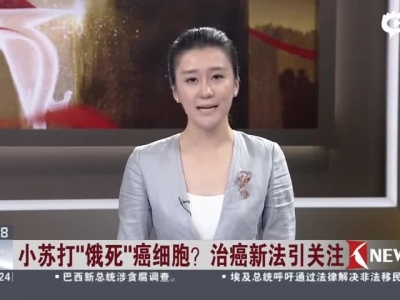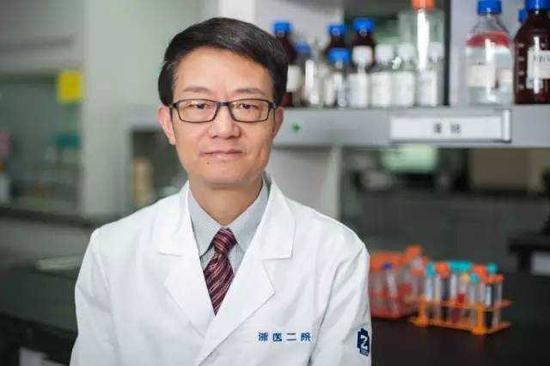Baking soda can "starve" the cancer cells? Party doctors respond to questions | bicarbonate | | medicine _ cancer cells news
 Baking soda "starve" the cancer cells? Cancer law attention
Baking soda "starve" the cancer cells? Cancer law attentionThese two days, as "baking soda to starve the cancer cells," the news, second affiliated hospital of Zhejiang University School of medicine, phones have been ringing up and down, from the President down to the emergency room, I received numerous calls.
This is Hu flood, Institute of Oncology of Zhejiang University professors and Zhejiang, two Interventional Science Professor Chao ming recently published in leading international journals a study on eLife.
In this study, they have 40-bit Advanced liver cancer patients to try a "TILATACE" treatment, effective response rate 100%, preliminary statistics on the total median survival period of 3.5 years.
News came out, instantly aroused heated discussion over the network, it was held, it was sprayed, and cancer as a life-saving straw, even patients flew to Hangzhou from Sichuan.
In the circumstances, are two professors did not expect. Today, this reporter once again spoke with two professors, netizens for several key issues of concern, as well as debates on the network, responded.
 Hu during flood season
Hu during flood seasonQ: eLife is what kind of academic journals?
Xun Hu: eLife is very good research magazine, relatively new, Wikipedia (Wikipedia) on the introduction to the magazine, its start-up funding from United States famous Seton Medical Center, Germany's Max Plank Society (Max Planck Society), the United Kingdom of Welcome Trust (Wellcome Trust) co-financing the creation, for nonprofit magazines. Editor in Chief is a famous Nobel Laureate in biology, University of Berkeley, biologist Randy Schekma, as far as I know, in its 20 senior editors, 10 are United States Academy of Sciences academician.
Q: for this study, the industry what assessment do you have?
Chao ming: to be honest, after the publication of the article, I have not a good look.
Xun Hu: this article was published on August 2, and also launched a major Editorial Board decided to offer letter (Decision Letter), the magazine's Editor, United States experts for this article, University of Pennsylvania, wrote a paragraph, you can take a look at.
Q: How does baking soda cure for cancer? Drink baking soda cure cancer?
Chao ming: drinking alkaline water is good for health, it is accepted wisdom. Good mineral water must be alkaline. However, the alkaline water have an anti-cancer effect? This is not research. Oral alkaline water, combat cancer? I don't know either. Abroad did have a reported case, a kidney cancer patient, not surgery, radiotherapy and chemotherapy, the doctors recommended him to drink soda. But this is an isolated case and does not represent a precise science, whether it is soda played a role, I don't know.
In our study, treatment is directed to nourish tumor blood vessels, tumors injected with sodium bicarbonate (baking soda), rather than drinking soda. We have always believed that this is a preliminary study, real science needs validation. A lot of people call me, first asked "is it true? I can firmly say, our research is real.
Q: baking soda for cancer treatment, in addition to liver cancer, malignant tumors for which effective?
Chao ming: this study has very strict defined for patients with primary hepatocellular carcinoma. Other tumors, also needs further study. But Hu team found the principle, common for many solid tumors, and how specific treatment needs to improve exploration, such as blood supply conditions, whether parts of the tumor, embolization, and so on.
For example, in brain tumor, embolization is hard to avoid normal tissue from damage; for example, muscle tumor embolism must very carefully, otherwise it will cause muscle necrosis.
Our study, in patients with primary hepatocellular carcinoma, report such a phenomenon, metastasis and recurrence of hepatocellular carcinoma is not within the scope of this research, and hope that more scholars to participate in this study.
Q: all liver cancer patients, can try this new therapeutic method?
Chao ming: first of all want the public to understand the fact that cancer is a systemic disease, needed treatment. Even in our study, also needs the cooperation of other departments, such as radiation therapy, liver cancer is easy to violate large vessels, treatment of tumor thrombus in precision radiation therapy needs to be done. So, this is not our personal success, and there are a lot of team effort.
TIlA-TACE current primary hepatocellular carcinoma in patients with end-stage, we have not overcome. From a medical perspective, the mass greater than 3 cm, medium term; vascular invasion or extrahepatic metastasis, belongs to the late. Massive ascites, jaundice, which belongs to the treatment of taboo.
Q: this treatment, when large-scale promotion?
Chao ming: this June, I and Professor Hu participated in the Asia-Pacific International Annual Conference on cardiovascular, has introduced this method in May this year, we hosted a Summit of innovation, have also been introduced, this is actually the promotion, if you are interested in other medical institutions, capable, and can also carry out this treatment.
However, our research, and subsequent big sample randomized controlled studies are needed. As for the when will I become a mature, conventional treatment programs, the result is a natural flow, we don't speed.
Q: effective response rate of 100%, what does it mean?
Chao ming: medical terminology to explain to the people of popular, may be misleading. Simply put, is the tumor that responds to this treatment, if no response is invalid.
Second, the reaction to what extent, to be effective? In this regard, there are many standards. RECIST criteria, the standards for effects of radiotherapy and chemotherapy, tumor shrinkage after treatment 50% as effective.
Another EASL standard and the criteria used in this study. Embolization, narrowing of the liver cancer takes a long time, EASL standard primary necrosis rate, necrosis, necrosis 50% above considered to be valid.
In our study, 40 patients, an effective response rate of 100%, this figure is true. Later made hundreds, of course there are invalid, but the overall effective rate is above 90%.
Question: 40-person study, the sample size is too small, can't explain the problem?
Xun Hu: clinical research, large sample studies, small samples, this is a small sample, single-center study.
We conduct our research is exploratory research (Pilot Study), and cutting-edge research. We are only leading role, to report such a phenomenon.
Chao ming: clinical research, there is a strict enrollment criteria, exclusion criteria. Treatment with real scenes are not the same.
Question: more than 10 bucks soda can "starve" cancer, does that mean that the future can significantly reduce the cost of treatment?
Chao ming: to improve the effect of reducing the number of repeat treatments, overall health care costs will be reduced. Larger liver tumors may need a lot of rounds cTACE, but this therapy improves the effectiveness of treatment, can reduce treatment times, thereby reducing the overall cost of treatment. Baking soda is a very cheap drug, spending did not increase basic cTACE according to preliminary findings, the residual tumor rate effect reflected by 80%
Xun Hu: according to the rate of residual tumor, in this study, after a single treatment of TILA-TACE tumor with an average residual tumor percentage cTACE Group 1/6 of the average percentage of residue, reflected the relative percentage of average residual tumor therapeutic effects by 80%.
Q: TILA-TACE is a brand new treatment, still in the original treatment of the reform? How to evaluate the effect of baking soda, is it true, as some people put it, just a bit of seasoning?
Chao ming: arterial infusion chemoembolization is the 70 's of the last century, Japan scholars and has been in use ever since, do have a curative effect. But this treatment have a bottleneck, efficacy is not high. So the two of us have been discussing, how can we improve the curative effect. So, with TILA-TACE.
Professor Hu published in 2012, research, innovation in cancer treatment, is the mechanism of innovation. So TILA-TACE have a scientific background, not for the better, is the innovation, Chinese scholars came up with a new idea.
Xun Hu: in our study, there are two found to be innovative:
1th, synergistic effect of lactate anion and hydrogen ions, making cancer cells is very frugal use of glucose in glucose rarely, in the absence of glucose to enter "sleep" State, when there is a supply of glucose to restore growth. Proposed lactate and hydrogen ions important in tumor cell tolerance glucose deprivation, published in the Journal of Pathology of 2012.
2nd, dissociation of lactic acid into lactic acid anion and hydrogen ions, they changed the mode of metabolism of tumor cells, let it waste is very frugal, puts forward the metabolism of tumor cells of the dual mode, Journal of Scientific Reports published in 2014 and 2016 in the journal Oncotarget.
In the us, Japan, researchers found that the body's normal blood sugar content is 6mmol/L, but only 0.1 mmol/l of tumors such as gastric cancer; in a separate study, researchers found that the tumours of intermittent or continuous glucose deficiency. Why such cases, cancer can live? We can research to explain it. But the real proof, there is a way.
Our experiments show that in mice, after injection of sodium bicarbonate at the tumor, tumor necrosis was observed, consistent with our laboratory findings. Although TILA-TACE in TACE was based on a treatment, but the action of baking soda, is key, rather than adjusting flavors of seasoning.
Q: this treatment have any side effects?
Chao ming: from our study, little side effects, can be tolerated because it is part of the chemotherapy, far less than the side effects of chemotherapy.
Q: what's next research project?
Chao ming: at present, we are all after the treatment of the patient's condition, being a statistic. ELife also hope that the progress reports on the follow-up study.
In addition, we are also doing a job, see the use of chemotherapy drugs, can achieve the same effect. In this study, patients were treated with chemotherapy. If you can (without chemotherapy), for the patient, will greatly alleviate suffering and medical expenses.
Q: on attention, debate on the network, what do you think of?
Chao ming: science, democracy and free debate is necessary and normal. It is important, with rigorous research and to testify, to promote scientific and technological progress. My wish is that from a scientific point of view, more verification, in front of nature and truth, we are just ants, the truth is the Giants.
Xun Hu: our research (including basic research, and clinical transformation) mainly represents the idea of a new treatment for cancer, has a theory of meaning. Hepatocellular carcinoma is the best model to test this idea. Indeed, we break through the bottleneck of the poor prognosis of liver cancer. This is a step forward, but it is far from the ultimate goal, requiring persistent efforts of our generation and the next generation. Next, as I want to have a quiet environment, and returned to the lab doing research.
I am a research worker, received a lot of phone calls and Email inquiries, inquiries are clinical issues and treatment, I am a layman, I hope everyone can understand.
Responsible editor: Wei chun
Article keywords:Baking soda cancer medicine
I want feedback
Save a Web page
Daily economic news
小苏打可以“饿死”癌细胞?当事医生回应质疑|小苏打|癌细胞|医学_新闻资讯
 小苏打“饿死”癌细胞?治癌新法引关注
小苏打“饿死”癌细胞?治癌新法引关注 这两天,因为“小苏打饿死癌细胞”的新闻,浙江大学医学院附属第二医院上上下下的电话都被打爆了,上至院长下至急诊科,都接到了无数咨询电话。
这是浙江大学肿瘤研究所胡汛教授和浙二放射介入科晁明教授团队近期发表在著名国际学术杂志eLife上的一项研究。
这项研究中,他们在40位晚期肝癌病人身上尝试了一种为“TILATACE”的治疗,有效反应率100%,初步统计病人的累计中位生存期已达3年半。
新闻一出,瞬间在网络上引起热议,有人捧,有人喷,而癌症患者视为救命稻草,甚至有患者直接从四川飞到了杭州。
这个局面,是两位教授不曾料到的。今天,本报记者再次采访了两位教授,对于网友们关心的几个关键问题,以及网络上的争论,做出了回应。
 胡汛
胡汛 问:eLife 是个什么样的学术杂志?
胡汛:eLife 是非常好的科研杂志,相对比较新,wikipedia(维基百科)上有关于这个杂志的介绍,它的启动资金,由美国著名的斯顿医学研究中心,德国的Max Plank Society(马克斯·普朗克学会)、英国的Welcome Trust(惠康基金会)共同资助创立,为非营利性杂志。总编是诺贝尔生物学奖得主、伯克利大学著名生物学家Randy Schekma,据我所知,它的20个资深编委中,有10个是美国科学院的院士。
问:对这个研究,业内对你们有什么评价?
晁明:说实话,文章发表之后,我自己还没有好好看看。
胡汛:这篇文章是8月2日发表的,与文章同时上线的还有一份编委决定录用的信(Decision Letter),杂志的编辑,美国宾夕法尼亚大学的专家给这篇文章,写了一段介绍,你们可以看一看。
问:小苏打是如何治疗癌症的?喝小苏打可以治疗癌症吗?
晁明:喝碱性水确实有益健康,这是公认的常识。好的矿泉水,一定是偏碱性的。但是,碱性水是否有抗癌的作用?这个没有研究。口服碱性水,是否能抗癌?我也不清楚。国外确实有个报道案例,一个肾癌患者,不能手术、放化疗,医生推荐他喝苏打水。但这是个别案例,不代表严谨的科学,是否是小苏打起了作用,不知道。
我们的研究中,采用的治疗方法是直接针对滋养肿瘤的血管,向瘤体注射碳酸氢钠(小苏打),而不是喝小苏打。我们始终认为,这只是一个初步的研究,真正的科学需要反复验证。很多人给我打电话,第一个问“是不是真的?我可以斩钉截铁的说,我们的研究是真实的。
问:小苏打治疗癌症,除了肝癌,对哪些恶性肿瘤有效?
晁明:本研究中有非常严格的定义,针对原发性的肝细胞肝癌患者。其他肿瘤,还需要进一步研究。但是胡教授团队发现的原理,对很多实体肿瘤有共性,具体如何治疗,需要进步一探索,比如肿瘤的部位、血供条件、能否进行栓塞等等。
比如,肿瘤长在脑部,栓塞的时候很难避免正常组织不受损伤;再比如,肌肉部位的肿瘤,栓塞必须很仔细,否则会造成肌肉坏死。
我们的研究,在原发性肝细胞肝癌患者身上,报告了这么一个现象,转移和复发的肝癌不在本研究范围之内,也希望今后有更多的学者参与到这个研究中来。
问:所有的肝癌患者,都可以尝试这种新的治疗方法吗?
晁明:首先希望公众明白一个事实:肿瘤是一个全身性疾病,需要综合治疗。即使在我们的研究中,也需要其他科室的配合,比如放疗,肝癌很容易侵犯大血管,治疗癌栓就需要做精准放疗。所以,这不是我们个人的成功,后面还有很多团队的努力。
TIlA-TACE目前针对原发性肝细胞肝癌的终末期患者,我们还没有突破。从医学角度来说,肿块大于3公分,就算中期;有脉管侵犯或肝外转移,就属于晚期。大量腹水、黄疸,这些属于本项治疗的禁忌。
问:这个治疗,什么时候可以大规模的推广?
晁明:今年6月份,我和胡教授参加的亚太心血管国际年会上,已经介绍了这个方法;今年5月,我们主办的一个创新高峰论坛上,也介绍过,这其实就是推广,其他医疗机构如果感兴趣,有能力,也可以开展这种治疗。
但是,就我们的研究来说,后续还需要大样本的随机对照研究。至于,什么时候才能成为一种成熟的、常规的治疗项目,结果是自然流淌出来的,我们不追求速度。
问:有效反应率100%,是什么意思?
晁明:医学有非常专业用语,向老百姓通俗的解释,可能会引起误解。简单说,就是肿瘤对这项治疗有反应,如果没反应,就是无效。
其次,反应到什么程度,才算有效?这方面,有很多标准。比如RECIST标准,这个标准主要针对放化疗的效果,治疗后肿瘤缩小50%认为有效。
另外还有EASL标准,也是本研究中采用的标准。栓塞治疗,肝癌的缩小需要经过很长时间,EASL标准主要看坏死率,坏死了多少,坏死50%以上认为是有效。
在我们的研究中,40例病人有效反应率100%,这个数字是真实的。后来又做了上百例,当然也有无效的,但总的有效率在90%以上。
问:40人的研究,样本量是不是太小,无法说明问题?
胡汛:临床研究,有大样本研究、小样本研究,我们这次是一个小样本、单中心的研究。
我们开展的研究是探索性的研究(Pilot Study),前沿性的研究。我们只是引领性的作用,向大家报告了这么一种现象。
晁明:临床研究,有很严格的入组标准、排除标准。与真实的治疗场景肯定不一样。
问:十几块钱的小苏打可以“饿死”癌细胞,是否意味着将来的治疗费用可以大大降低?
晁明:提高疗效减少了重复治疗的次数,总体的医疗费用一定会得到降低。比较大的肝癌肿瘤,可能会需要很多轮次的cTACE,但这个疗法提高了治疗的有效性,可以减少治疗次数,从而减少总体治疗费用。小苏打是一种非常便宜的药物,并没有增加原来基础cTACE的费用根据初步研究结果,反映出来的肿瘤残留率相对治疗效果提高80%
胡汛:根据肿瘤残留率来讲,在这个研究中,单次治疗后TILA-TACE组肿瘤平均残留百分率是cTACE组的肿瘤平均残留百分率的1/6,用肿瘤平均残留百分率反映出来的相对治疗效果提高了80%。
问:TILA-TACE是一个全新的治疗,还是在原有治疗手段上的改良?怎么评价小苏打的作用,是否真像有些人说的那样,只不过一点佐料?
晁明:动脉插管化疗栓塞术是上世纪70年代,由日本学者提出的,一直沿用至今,确实有疗效。但这个治疗有一个瓶颈,疗效不高。所以我们两人一直在探讨,如何能提高疗效。于是,有了TILA-TACE。
胡教授2012年发表的研究,是肿瘤治疗思路的创新,是机制的创新。所以TILA-TACE 是有科学背景的,不是改良,是创新,是中国学者提出来的一种新的治疗思路。
胡汛:我们的研究中,有两个发现是创新的:
第1, 乳酸阴离子和氢离子的协同作用,使得肿瘤细胞在葡萄糖很少时非常节约地利用葡萄糖,在没有葡萄糖进入的情况下进入“休眠”状态,当有葡萄糖供应时即可恢复生长。提出了乳酸根和氢离子在肿瘤细胞耐受葡萄糖剥夺中的重要做用,发表在2012年的Journal of Pathology。
第2, 乳酸解离成乳酸阴离子和氢离子,它们改变了肿瘤细胞的代谢模式,让它从非常浪费变成非常节约,提出了肿瘤细胞的双重代谢模式,发表在2014年的Scientific Reports杂志上和2016年的Oncotarget杂志上。
在我们之前,日本研究人员发现,人体的正常血液中,糖的含量是6mmol/L,但肿瘤中如胃癌只有0.1 mmol/L;另外一个研究中,科研人员发现,肿瘤中存在间歇性或者持续性的葡萄糖缺乏。为什么这样的情况下,肿瘤还能活?我们的研究可以来解释它。但是,可能离真正的证明,还有一段路。
我们在小鼠身上的实验证明,在肿瘤旁注射碳酸氢钠之后,可以观察到肿瘤的大面积坏死,符合我们在实验室的发现。虽然TILA-TACE是在TACE基础上的一个治疗,但小苏打的作用,是非常关键的,而不是调节口味的佐料。
问:这个治疗,有没有什么副作用?
晁明:从我们的研究来看,副作用不大,完全可以耐受,因为是局部的化疗,远小于全身化疗的副作用。
问:接下来有什么研究计划?
晁明:目前,我们正在对所有经过这项治疗的病人的情况,做一个统计。eLife也希望我们报告后续的研究进展。
另外,我们还在做一个工作,看看不使用化疗药物,能否取得同样的治疗效果。这项研究中,病人都是接受化疗的。如果可以(不用化疗),对病人来说,就可以大大减轻痛苦和医疗费用。
问:对网络上的关注、争论,你们是怎么看的?
晁明:对于科学问题,民主和自由的争鸣是十分必要和正常的。重要的是,用严谨的研究和实践去证明,去推动科学技术进步。我的愿望是,从科学的角度,得到更多的验证,在自然规律和真理面前,我们都只是蚂蚁,真理才是巨人。
胡汛:我们的研究(包括基础研究和临床转化)主要代表了一个治疗肿瘤的新的思路,有理论上的意义。肝细胞肝癌是检验这个思路的最好的模型。确实,我们突破了大肝癌疗效差的瓶颈。这是一个进步,但离终极目标还很远,因此需要我们这一代人乃至下一代人坚持不懈的努力。接下来,作为我,希望有个安静的环境,回到实验室脚踏实地地做研究。
我是一个基础研究工作者,接到很多电话和Email来询问,询问的都是临床问题,而临床治疗,我是外行,希望大家能理解。
责任编辑:隗俊
文章关键词: 小苏打 癌细胞 医学
我要反馈
保存网页
每日经济新闻